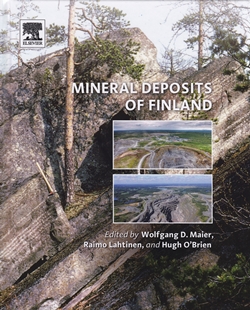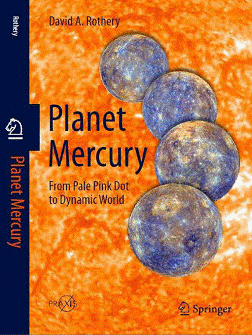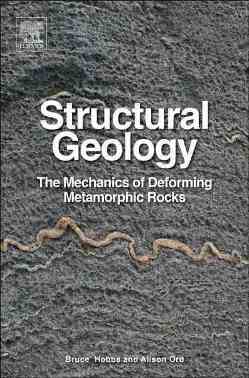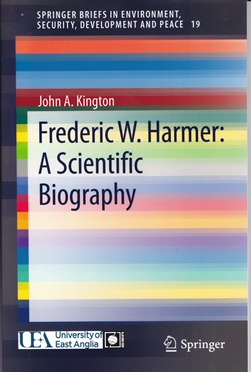 Mineral Deposits of Finland
Mineral Deposits of Finland
Finland is a major European hub for mineral exploration and mine development. The country hosts Europe's oldest rock units and large cratonic blocks, analogous to Western Australia and Southern Africa. Although commodity prices are currently low, one development in the last boom was the recognition that many of the world’s currently active ore producing districts are extremely mature and future resources will have to come from different locations.
Thus this volume fills a gap in the market to provide an up-to-date and inclusive reference available that fully captures the scope of Finland's mineral deposits and their economic potential. It certainly delivers, providing comprehensive coverage of the major mineral occurrences in Finland. But this is significantly more than just a catalogue of occurrences – it is a major piece of scientific work. Each chapter is authored by a group of experts in their field and provides a comprehensive description of the mineral deposits discussed, techniques used in exploration and implications for mineral exploration and extraction.
The book is organised into parts that provide a summary of ore deposit discoveries in Finland; metallogensis of Finland and the surrounding areas; description of magmatic Ni-Co-Cu-Cr-V-PGE deposits; Carbonatite deposits (including kimberlites); Gold deposits; IOCG; VMS; Granite hosted; Black shale and other deposits; Exploration methods and resource definition.
Overall, this organisation is good, and each part is split into chapters where multiple deposits occur - each deposit representing a chapter. Sometimes this can be a little confusing, such as the placement of Sokli Carbonatite deposits in with ‘Black shale and other’ deposits rather than with Carbonatites; but these are minor points. Overall the book provides a logical study of Finnish mineral deposits.
The volume editing is good and the work largely free of errors. The illustrations are also good and informative. The book should be essential reading for anyone working in Finland in mineral exploration or economic geology - and more widely by those interested in the geology of Europe. The book would make an excellent template to be applied to other parts of the world.
Reviewed by Rob Bowell
MINERAL DEPOSITS OF FINLAND by WOLFGANG DEREK MAIER, RAIMO LAHTINEN & HUGH O'BRIEN (eds) 2015. Published by: Elsevier; 802pp ISBN: 978-0-12-410438-9 (hbk). Ebook available. List Price: £190.00. W: http://store.elsevier.com/product.jsp?isbn=9780124104389
 Planet Mercury – from Pale Pink Dot to Dynamic World
Planet Mercury – from Pale Pink Dot to Dynamic World
Messenger’s Mercury mission ended today, the day of writing, with a bang and silence, according to the BBC. The mission was remarkably successful, despite widespread doubt that the probe would reach Mercury. Originally planned to include one year orbiting the planet, it was extended twice and lasted four years. It finished when Messenger crashed into the surface because its fuel ran out. The mission produced 270,000 images and 10 terabytes of data.
The book comprises seven, well-illustrated chapters: the first being a good summary of pre-space-age knowledge of the planet. The next three chapters describe, in turn, the probes and equipment for Mariner 10 (NASA, launched 1974), Messenger (NASA, 2004), and BepiColombo (ESA, scheduled 2016). Fairly detailed technical information is presented but, at 64 pages, might be thought to occupy too much of the book. Some will want even more detail, of course.
The remaining chapters give an extended outline of what was learnt from Mariner 10 and Messenger. Much relates to the differing terrains across Mercury’s surface – from craters to extensive plains (which cover 27% of the surface), with quasi-linear rises, etc. These major types of topographic feature are fundamental to any understanding of elemental and/or mineral distribution, etc, on which there is also a wide spread of information. Clear evidence exists, among other things, of crustal shortening.
After the surface which, naturally, is covered thoroughly, are chapters dealing with the planet’s interior – from mantle to inner core – its exosphere, and its somewhat strange magnetic field, which is off-centre vertically on the rotational axis. The occasional, small, information gems in the book are excellent. Thus, one might think that the sun’s proximity would prevent “water” from remaining near the planet’s surface. In fact, there is thought to be ice in deep craters near the north pole, never touched by sunlight because of the angle of incidence. A metre of ice here would take 1 billion years to sublime. If it were covered by 10cm lag deposits, the rate would slow a thousand-fold, to one millimetre per billion years.
The editing is disappointing at times, with confusing text and inexplicable variations in the diameter of the same crater. It might have been useful, beyond this, to include both a glossary and a map showing the principal features discussed. Notwithstanding these issues, this is a good book and a pleasure to own. It will live where it can be found easily.
Reviewed by Jeremy Joseph
PLANET MERCURY – FROM PALE PINK DOT TO DYNAMIC WORLD by David A Rothery, 2015. Published by: Springer International Publishing Switzerland. ISBN: 978-3-319-12116-1. Hbk. 180pp. List Price €59.49. www.springer.com/series/4097
 Structural Geology – The Mechanics of Deforming Metamorphic Rocks. Volume 1: Principles.
Structural Geology – The Mechanics of Deforming Metamorphic Rocks. Volume 1: Principles.
Structural geology has been informed and fundamentally transformed by significant developments made in other allied and interdisciplinary sciences. Recent advances in metamorphic petrology, tectonics and geodynamics, physical metallurgy, non-linear chemical dynamics, continuum mechanics, non-linear mechanics and thermodynamics have revealed important understandings of the deformational and metamorphic processes operating within the Earth. These insights have often been obtained independently and not integrated fully within the broader framework of metamorphic and structural geology. This book attempts to address this omission and establish a current comprehensive synthesis.
The volume initially develops the basic foundations in mechanics where thermodynamics has a pivotal contribution and then applies these principles to rock masses where factors such as deformation, fluid flow, thermal transport, mineral reactions and microstructural rearrangements influence the evolution of the rock fabric and generate the structures geoscientists observe. The volume is arranged into two main parts, each introduced with an overview section.
Part A is a modern treatment of mechanics including geometry, kinematics, non-linear dynamics and thermodynamics of deforming systems. Particular emphasis is placed on the principles of non-linear behaviour of deforming and chemically reactive systems, a significant change in approach from existing texts.
Part B considers the processes involved in the development of geological structures such as brittle and visco-plastic flow, heat and fluid flow, damage evolution, microstructural rearrangements and non-linear mineral reaction kinetics. A basic knowledge of structural geology and metamorphic petrology is assumed, with a necessary mathematical emphasis on the treatment of the subject. Brief appendices on elementary differential calculus and tensor algebra are included.
With a combined research and teaching experience of over 70 years, the volume is written by two of the pre-eminent authorities in the field. Written in a clear and concise style, the book is presented with numerous (over 300) figures, graphical drawings and photographs that appropriately supplement the accompanying text. Many of these are in colour and significantly enhance the understanding of the textual details.
The expected audience are graduate geoscientific researchers and professional structural geologists and metamorphic petrologists both in academia and industry. A long overdue treatment of the subject, this book is highly recommended and anticipated to become established as a standard reference work.
Reviewed by Mark Griffin
STRUCTURAL GEOLOGY – THE MECHANICS OF DEFORMING METAMORPHIC ROCKS. VOLUME 1: PRINCIPLES. Bruce E. Hobbs and Alison Ord. Elsevier. 2015. ISBN 978-0-12-407820-8. Hbk. 665pp. List Price: £79.00, http://store/elsevier.com
 Frederick W Harmer - a scientific biography
Frederick W Harmer - a scientific biography
Many of the fundamental principles and concepts that underpin geology were given to us a long time ago and when we use or refine them we usually don’t remember, let alone give credit to, their originators. In the last couple of years we have celebrated 'The Father of English Geology', William Smith, but what of the other pioneers? John Kington sets out with the express purpose of reminding us of the importance of Frederic Harmer (1835-1923). The style of Kington’s narrative is very much 'matter of fact' and there are no revelations to excite the tabloid press; but Peter Norton’s excellent Foreword is more open and launches the subject into its historical and socio-economic context.
Harmer is most commonly remembered for his studies based on East Anglian Crag molluscs. Kington takes us through this work and describes how Harmer established a biostratigraphy, identified a cooling trend and expanded on Searles Wood Sr’s monograph. But Kington rightly reminds us that Harmer investigated the post-Crag Quaternary. There is particular reference to collaboration with Searles Wood Jr in identifying different ice-sheets from the composition of their tills and in the production of what these collaborators considered to be the first drift map. The author also takes us through what were early discussions on phenomena of recent research importance viz: a pre-glacial River Thames, glacial lakes, post-glacial fluvial misfits and gaps and differential tilting of the landmass. It was Harmer who introduced the concept of glacial Lake Oxford, an oversight that is firmly redressed.
The author is an expert on historical meteorology and he comes into his own in demonstrating that Harmer was ahead of his time in modelling climate change. Drawing on work that has virtually been overlooked, there is commemoration of the recognition of the importance of global wind patterns, and especially the role of anti-cyclones, in controlling climate. Kington also recounts how the modelling progressed to account for climatic changes that accompanied changes to the landmasses. Personally, I am grateful to Kington for resurrecting Harmer’s assertion of the increased significance of easterly gales in Crag times.
The book includes a useful list of Harmer’s published and draft works. Among the illustrations are two detailed geological maps and 39 photographs but the quality of their reprographics is disappointing. Despite this and a couple of minor errors, this is the most comprehensive and authoritative account of Harmer’s life and work and it achieves its goal of recollecting Harmer’s pioneering achievements.
Reviewed by Howard Mottram
FREDERIC W HARMER: A SCIENTIFIC BIOGRAPHY (SPRINGER BRIEFS IN ENVIRONMENT, SECURITY, DEVELOPMENT AND PEACE, VOL 19) by
JOHN A KINGTON, 2014. Published by: Springer-Verlag ISBN 9783319077031: 97pp (sbk): List Price £44.99. W:
www.springer.com/gp/book/9783319077031